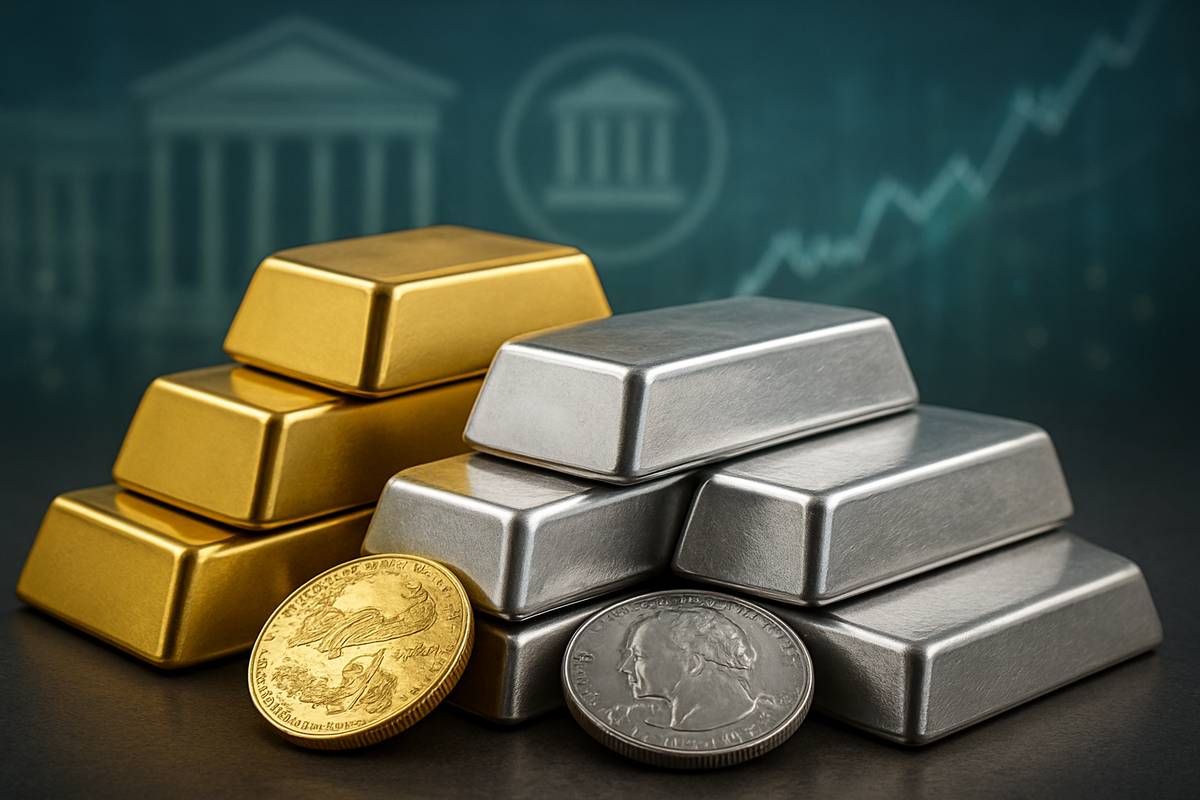
The precious metals market, particularly gold and silver, is experiencing a significant uplift as of late 2025, driven by a confluence of supportive regulatory actions and an increasingly bullish investor sentiment. Amidst persistent global economic uncertainties, escalating geopolitical tensions, and a strategic pivot by central banks, these tangible assets are once again asserting their role as indispensable safe havens. Recent legislative efforts at the state level in the U.S. to reduce tax barriers and affirm gold and silver as legal tender, alongside federal transparency initiatives, are creating a more favorable environment for precious metal ownership and trade.
Simultaneously, a palpable shift in investor psychology, characterized by a flight to quality and a renewed focus on inflation hedges, is providing robust demand-side support. With the Federal Reserve signaling further interest rate cuts and industrial demand for silver soaring due to the green energy transition, the stage appears set for sustained upward momentum in both gold and silver, challenging traditional financial asset allocations and reshaping investment strategies for the foreseeable future.
Regulatory Shifts and Monetary Policy Paving the Way
The landscape for precious metals has been significantly reshaped by a series of legislative and policy developments throughout 2024 and 2025. A notable trend has been the widespread adoption of state-level tax exemptions for gold and silver bullion. By January 2025, an impressive 45 U.S. states had eliminated sales taxes on precious metal purchases, with New Jersey (Senate Bill 721, January 2025) and Kentucky leading the charge. This legislative wave signals a growing recognition of gold and silver as sound money, aiming to reduce barriers for individuals to acquire and hold these assets. Furthermore, states like Nebraska (Legislature Bill 1317, January 2025) have gone a step further, repealing capital gains taxes on precious metal sales and explicitly excluding central bank digital currencies (CBDCs) from their definition of money, highlighting a broader movement towards financial autonomy.
Beyond tax relief, several states—including Louisiana (May 2024), Missouri (July 2025), Texas (June 2025), Florida (June 2025), and Arkansas (April 2025)—have passed laws reaffirming gold and silver as legal tender. While the practical implementation of these laws for everyday transactions faces significant logistical and constitutional hurdles, they represent a symbolic and legal reinforcement of precious metals' monetary status. On the federal front, the proposed "Gold Reserve Transparency Act," championed by Senator Mike Lee of Utah, aims to mandate systematic auditing procedures for the United States' gold holdings. This initiative, if enacted, would enhance confidence in the integrity of national reserves through independent third-party assessments and coordination with external auditors, potentially bolstering trust in the U.S. financial system's underlying assets.
Trade policies and tariffs are also emerging as critical factors. Discussions in 2025 are expected to focus on restructuring tariff rates on imported gold, introducing new tariffs on silver used in electronic components (targeting major exporters), and adjusting for a harmonized tariff framework across trade blocs. Environmental tariffs on mining operations with high carbon footprints are also on the table. These policies could influence global supply chains, accessibility, and ultimately the price points of precious metals, potentially leading to increased volatility and shifts in sourcing strategies for refiners and manufacturers.
However, arguably the most impactful governmental action comes from central bank monetary policies. The U.S. Federal Reserve's anticipated interest rate cuts throughout 2025 are a primary driver of precious metal prices. Following a 25-basis-point rate cut in December 2024, market expectations are high for further reductions. Lower nominal interest rates diminish the opportunity cost of holding non-yielding assets like gold and silver, making them comparatively more attractive than interest-bearing investments. This dovish stance by the Fed, signaled by officials like New York Fed President John Williams, directly fuels investor sentiment and contributes to the upward trajectory of gold and silver valuations.
Corporate Fortunes Forged in Precious Metals
The bullish shift in the gold and silver markets is directly translating into significant opportunities and challenges for public companies across the mining, refining, and investment fund sectors. Mining companies, in particular, are witnessing enhanced profitability driven by elevated commodity prices and robust investor interest. Giants like Newmont Corporation (NYSE: NEM), the world's largest gold producer, have seen their stock surge by an impressive 80% year-to-date in 2025, reflecting the strong market sentiment. Other major players such as Barrick Gold Corporation (NYSE: GOLD), Agnico Eagle Mines Limited (NYSE: AEM), Wheaton Precious Metals Corp. (NYSE: WPM), and Pan American Silver Corp. (NASDAQ: PAAS) are similarly positioned to capitalize on sustained high prices. While senior producers initially led the advance, mid-tier companies are now following suit, indicating a broadening bull market. Silver mining stocks, despite their inherent volatility, are also projected to outperform during periods of heightened market uncertainty, though companies with higher operational costs could face margin pressures if prices were to correct.
The refining sector is also poised for significant growth. Companies such as Umicore, Heraeus, Johnson Matthey, Asahi Refining, and Metalor Technologies stand to benefit from the increasing demand for precious metals across various industries, including jewelry, electronics, and automotive. Furthermore, advancements in refining technologies and the growing emphasis on recycling are creating new avenues for expansion. Refiners that invest in sustainable practices and establish robust recycling networks are strategically positioned to capture a larger share of this expanding market. The increased flow of physical metal, spurred by investor demand and central bank purchases, provides a consistent supply for these refiners, ensuring operational efficiency and potential for higher throughput.
Investment vehicles, particularly Exchange-Traded Funds (ETFs), are experiencing unprecedented capital inflows. Major gold and silver ETFs like SPDR Gold Shares (NYSE Arca: GLD) and iShares Silver Trust (NYSE Arca: SLV) have added hundreds of tonnes of physical metal to their holdings, underscoring the accelerated institutional and retail investor demand. Gold ETFs in India, for instance, recorded record inflows of ₹8,363 crore in September 2025, with silver ETFs also seeing substantial increases. This trend highlights a broader rotation into safer assets amidst stock market volatility. While some European gold ETFs have seen outflows, robust inflows in North America and Asia, coupled with the premium pricing maintained by funds like Sprott Physical Gold Trust, signal strong global investor confidence. These inflows provide liquidity and support for the underlying precious metal markets, further benefiting the entire ecosystem.
Broader Implications and Historical Parallels
The current trajectory of the gold and silver markets extends far beyond mere price movements, reflecting deeper shifts in global finance and geopolitics. This surge in precious metals demand fits squarely into broader industry trends characterized by increasing economic nationalism, de-dollarization efforts, and a pervasive search for tangible assets amidst inflationary pressures. The widespread state-level tax exemptions and legal tender affirmations for gold and silver in the U.S. are not isolated events; they are symptoms of a growing distrust in fiat currencies and a desire for alternative monetary systems, potentially influencing similar legislative considerations in other nations. This trend is further amplified by discussions around central bank digital currencies (CBDCs), where the explicit exclusion of CBDCs from the definition of money in some states underscores a pushback against centralized digital control and a preference for decentralized, physical stores of value.
The potential ripple effects on competitors and partners are substantial. As precious metals gain prominence, traditional financial assets, particularly those sensitive to interest rate hikes or equity market volatility, may see capital reallocated. This could put pressure on bond markets if investors opt for physical gold over sovereign debt, or on equity markets if safe-haven flows divert from growth stocks. For partners in the supply chain, such as exploration companies, equipment manufacturers, and logistics providers, the buoyant market translates into increased business opportunities. However, new trade policies and tariffs, particularly those targeting specific imports or environmentally impactful mining operations, could introduce complexities and necessitate supply chain recalibrations for global refiners and dealers.
Regulatory and policy implications are profound. The proposed "Gold Reserve Transparency Act" at the federal level, while specific to U.S. gold holdings, could set a precedent for greater accountability and auditing standards for national reserves globally. This move towards transparency could bolster confidence in sovereign wealth and potentially influence international financial agreements. Historically, periods of significant economic uncertainty, geopolitical instability, and high inflation have consistently driven investors towards gold and silver. The 1970s, characterized by oil shocks and stagflation, saw gold prices skyrocket. More recently, the post-2008 financial crisis era and ongoing geopolitical tensions have consistently reaffirmed precious metals' role as safe havens. The current environment, with its unique blend of state-level monetary activism, federal transparency pushes, and central bank diversification, suggests a modern-day reassertion of these historical patterns, albeit with new regulatory nuances.
The Road Ahead: Scenarios and Strategic Pivots
Looking ahead, the gold and silver markets are poised for continued dynamism, with several short-term and long-term possibilities emerging. In the short term, the Federal Reserve's anticipated interest rate cuts throughout 2025 are expected to remain a primary catalyst, reducing the opportunity cost of holding non-yielding assets and providing further upward momentum for prices. Gold's resilience above the $4,000 per ounce mark and silver's strong performance around $50 per ounce suggest a robust floor, with forecasts projecting gold to average around $3,675/oz by Q4 2025 and potentially reaching $5,000/oz by mid-2026. Silver, with its gold-to-silver ratio exceeding 90 earlier in the year, appears undervalued relative to gold and could see a more aggressive upward correction.
For investors, strategic pivots will be crucial. A continued allocation to precious metals, ranging from a conservative 5-10% to a more aggressive 15-20% for those seeking significant inflation protection, is being widely recommended. Diversification within the precious metals sector, including physical bullion, mining stocks, and ETFs, can mitigate risk. Companies in the mining and refining sectors will likely focus on optimizing production, exploring new deposits, and enhancing cost efficiencies to capitalize on higher prices. Investment in sustainable mining practices and advanced refining technologies will also be key to navigating potential environmental tariffs and meeting growing industrial demand, especially for silver in green energy applications.
Potential market opportunities may emerge in niche areas, such as the development of electronic payment platforms that facilitate the use of gold and silver as currency, as envisioned by some state legal tender laws. Challenges include potential reversals in central bank monetary policy if inflation proves more stubborn than anticipated, or unexpected geopolitical de-escalations that could temporarily dampen safe-haven demand. However, the overarching trend of central bank gold accumulation and robust industrial demand for silver provides a strong fundamental backdrop. Potential scenarios include a sustained bull market driven by continued de-dollarization and inflation, or a more volatile environment where precious metals act as a crucial hedge against intermittent market shocks.
A Golden Horizon: Navigating the Future of Precious Metals
In summary, the gold and silver markets are currently experiencing a powerful confluence of favorable regulatory developments, robust investor sentiment, and strategic central bank actions that collectively point towards a sustained bullish outlook. Key takeaways include the widespread state-level initiatives to reduce tax burdens on precious metals, the federal push for greater transparency in gold reserves, and the pivotal role of central bank monetary policies, particularly interest rate cuts, in enhancing the appeal of non-yielding assets. Investor sentiment, fueled by global economic uncertainties and a flight to safety, continues to drive significant capital into both physical metals and related equities and ETFs.
Moving forward, the precious metals market is likely to remain a cornerstone of diversified investment portfolios. The consistent demand from central banks, coupled with the burgeoning industrial applications of silver in the green energy transition, provides a strong fundamental floor for prices. While short-term volatility is always a possibility, particularly concerning geopolitical events or shifts in monetary policy rhetoric, the long-term drivers appear firmly in place. The ongoing re-evaluation of fiat currencies and the search for stable stores of value are cementing gold and silver's enduring significance in the global financial landscape.
Investors should closely monitor several key indicators in the coming months: the pace and extent of Federal Reserve interest rate adjustments, further developments in state and federal precious metals legislation, and the continued trend of central bank reserve diversification. Geopolitical flashpoints and global inflation data will also play a crucial role in shaping safe-haven demand. For public companies in the sector, strategic investments in efficiency, sustainability, and market expansion will be critical to capitalizing on this golden horizon. The era of precious metals as merely an alternative investment is evolving; they are increasingly recognized as a fundamental component of resilient wealth preservation and growth strategies.
This content is intended for informational purposes only and is not financial advice






